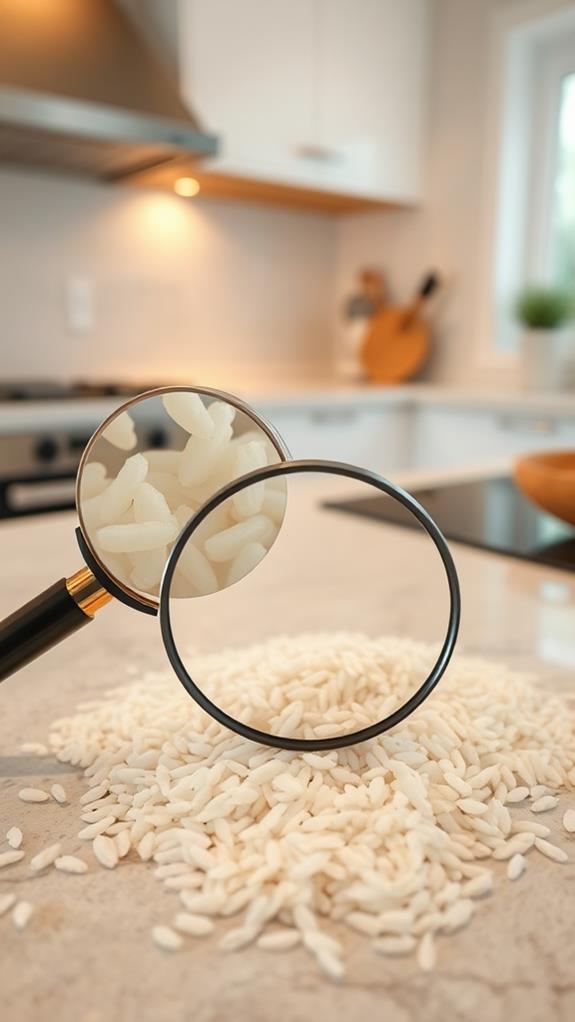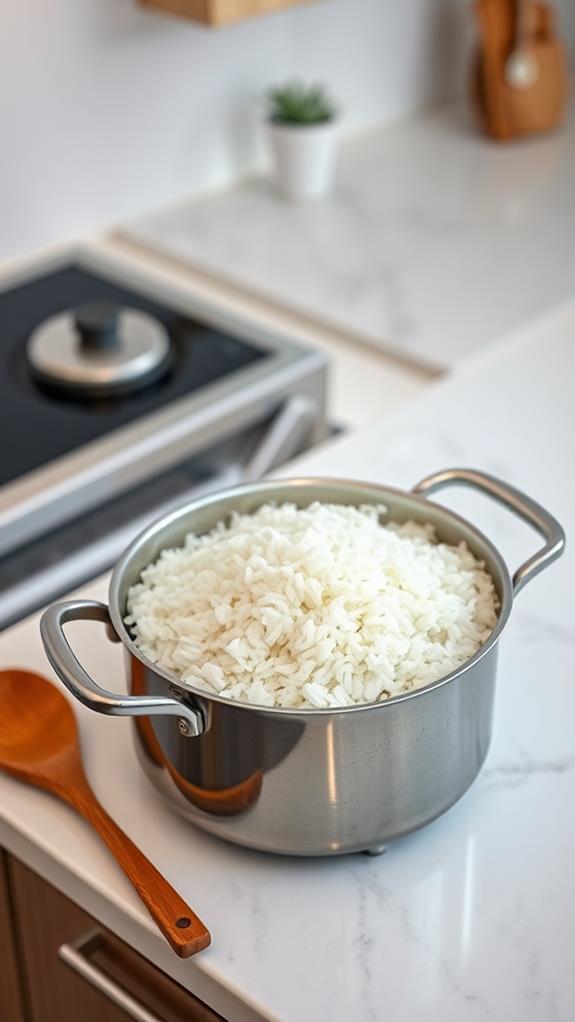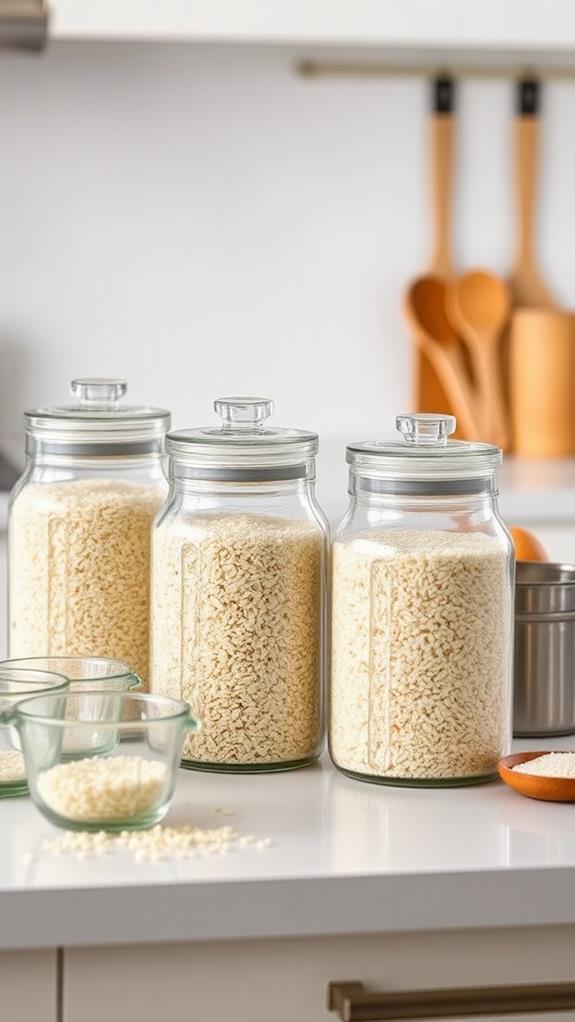Is It Safe to Eat Undercooked Rice
Eating undercooked rice isn't safe due to the potential presence of Bacillus cereus, a bacterium that can cause food poisoning. These bacteria survive the cooking process and multiply rapidly in undercooked rice, producing toxins that lead to nausea, vomiting, and diarrhea. To guarantee safety, cook rice thoroughly using proper techniques: rinse it first, use a 2:1 water-to-rice ratio, and simmer for the recommended time based on the rice variety. Properly cooked rice should be tender and fluffy, with distinct grains. If you're unsure, perform a bite test; undercooked rice feels hard and crunchy. Understanding these risks and proper cooking methods will help you enjoy rice safely and confidently.
This post may contain affiliate links. If you make a purchase through these links, I may earn a commission at no additional cost to you. Additionally, portions of this post may be generated using artificial intelligence (AI) technology. While we strive for accuracy, please be aware that AI-generated content may not always be perfect and should be fact-checked when necessary.
The Spatula Scoops
- Eating undercooked rice can expose you to Bacillus cereus, potentially causing food poisoning.
- Undercooked rice contains hard, crunchy grains with a visible chalky center.
- Symptoms of rice-related food poisoning include nausea, vomiting, diarrhea, and abdominal cramps.
- Properly cook rice by simmering for 18-20 minutes (white) or 35-40 minutes (brown) until tender.
- Store cooked rice in the refrigerator within two hours and reheat to 165°F (74°C) before consuming.
Understanding Rice and Bacteria

Two key factors make rice a potential breeding ground for bacteria: its starchy composition and moisture content. When you cook rice, you're not just preparing a meal; you're engaging in a delicate balancing act with microorganisms. Rice contains spores of Bacillus cereus, a bacterium that can cause food poisoning. These spores survive the cooking process and, if left at room temperature, can multiply rapidly. Nearly half of commercial rice samples test positive for this bacteria, highlighting the importance of proper cooking and storage practices.
The starch in rice provides an excellent food source for bacteria, while the moisture creates an ideal environment for growth. This combination makes undercooked or improperly stored rice a potential health hazard. It is essential to understand that bacteria can proliferate even when rice appears perfectly fine to the naked eye.
To mitigate risks, you should cook rice thoroughly, reaching an internal temperature of at least 165°F (74°C). Once cooked, serve it promptly or cool it quickly and refrigerate within an hour. When reheating, make certain the rice reaches a steaming hot temperature throughout. By following these precautions, you'll greatly reduce the risk of bacterial growth and potential foodborne illness associated with undercooked rice.
Risks of Consuming Undercooked Rice
Understanding the bacterial risks associated with rice sets the stage for exploring the specific dangers of consuming it undercooked. When you eat rice that's not fully cooked, you're exposing yourself to potential health hazards. The main culprit is Bacillus cereus, a bacteria that can survive the cooking process and multiply rapidly when rice is left at room temperature. Similar to the risks associated with medium rare burgers, undercooked rice can harbor harmful bacteria that pose significant health risks, especially to vulnerable populations.
Food poisoning symptoms, including nausea, vomiting, and diarrhea
Abdominal pain and cramps
Dehydration due to fluid loss from gastrointestinal distress
These symptoms can range from mild to severe, depending on the amount of contaminated rice consumed and your individual health status. In some cases, the toxins produced by Bacillus cereus can lead to more serious complications, especially for those with weakened immune systems, young children, and the elderly.
It's important to note that even if rice appears cooked on the outside, the interior may still harbor harmful bacteria. To guarantee your safety, always cook rice thoroughly until it's steaming hot throughout and avoid consuming any grains that feel hard or crunchy.
Proper Rice Cooking Techniques

To guarantee your rice is safe to consume, mastering proper cooking techniques is essential. Start by thoroughly rinsing your rice to remove excess starch and any potential contaminants. Use a 2:1 ratio of water to rice for most varieties, though this may vary slightly depending on the type of rice you're cooking.
Bring the water to a boil before adding your rice. Once added, reduce the heat to low and cover the pot with a tight-fitting lid. This creates a steaming environment, vital for even cooking. Let the rice simmer for about 18-20 minutes for white rice, or 35-40 minutes for brown rice. Avoid lifting the lid during cooking, as this releases steam and affects the cooking process. When using premium sushi rice, such as Nishiki, consider using the palm technique to determine the correct water level for cooking more than 1 cup, verifying perfect results every time.
After the allotted time, remove the pot from heat and let it stand, covered, for an additional 5-10 minutes. This resting period allows for even distribution of moisture. Finally, fluff the rice with a fork before serving. Using a rice cooker can simplify this process and guarantee consistent results. Remember, properly cooked rice should be tender and fluffy, with no hard or crunchy grains remaining.
Identifying Undercooked Rice
Recognizing undercooked rice is pivotal for both food safety and enjoyment. When you're evaluating your rice, look for these key indicators:
- Texture: Undercooked rice feels hard and crunchy when bitten.
- Appearance: It often has a chalky center visible in individual grains.
- Water absorption: You'll notice excess water in the pot or a lack of fluffiness.
As you examine your rice, you'll want to inspect its consistency. Properly cooked rice should be tender and fluffy, with each grain distinct. If you're unsure, try the bite test. Take a small amount and chew it; if it's resistant or grainy, it's likely undercooked.
Visual cues are also important. Undercooked rice may appear opaque rather than translucent. You might see a white, starchy center in the grains. This indicates that the starch hasn't fully gelatinized, a process essential for proper cooking.
Safe Rice Storage Practices

Storing rice properly is essential for maintaining its quality and preventing foodborne illness. You'll want to keep uncooked rice in an airtight container in a cool, dry place. This helps prevent moisture and pests from contaminating your rice. Once you've cooked rice, it's imperative to refrigerate it within two hours to prevent bacterial growth.
When storing cooked rice, use shallow containers to allow for quick cooling. You can keep cooked rice in the refrigerator for up to four days. If you need to store it longer, consider freezing it. Frozen rice can last up to six months when stored properly in airtight containers or freezer bags.
Before reheating stored rice, make sure it's thoroughly heated to an internal temperature of 165°F (74°C) to kill any potential bacteria. Don't leave reheated rice at room temperature for extended periods, as this can lead to bacterial growth. If you're meal prepping, portion your rice into single servings for easy reheating and to minimize waste. By following these storage practices, you'll maintain the quality of your rice and reduce the risk of foodborne illness.
Frequently Asked Questions
Can Pregnant Women Eat Slightly Undercooked Rice?
As a pregnant woman, you should avoid eating undercooked rice. It's best to guarantee your rice is thoroughly cooked to reduce the risk of foodborne illnesses. Uncooked rice can harbor harmful bacteria like Bacillus cereus, which may cause food poisoning. During pregnancy, your immune system is compromised, making you more susceptible to infections. To stay safe, always cook rice until it's steaming hot and fully tender. If you're unsure about the rice's doneness, it's better to err on the side of caution and cook it longer.
Does Soaking Rice Before Cooking Reduce the Risk of Foodborne Illness?
Did you know that soaking rice can reduce arsenic levels by up to 80%? While this statistic is impressive, it's not directly related to foodborne illness risk. Soaking rice before cooking doesn't considerably reduce the risk of pathogens like Bacillus cereus. However, it can improve texture and reduce cooking time. To minimize foodborne illness risk, you should focus on proper cooking techniques, ensuring your rice reaches a safe internal temperature of 165°F (74°C), and storing leftovers correctly.
Are There Any Health Benefits to Eating Raw or Sprouted Rice?
You might wonder about health benefits from raw or sprouted rice. While sprouted rice can offer increased nutrients like gamma-aminobutyric acid (GABA) and improved digestibility, eating raw rice isn't recommended. It's hard to digest and may contain harmful bacteria. Sprouted rice, however, can boost vitamin and mineral content, potentially aiding in digestion and providing antioxidants. Remember, though, that any benefits should be weighed against potential risks, and it's always best to consult a healthcare professional before making significant dietary changes.
Can Pets Safely Consume Undercooked or Raw Rice?
You shouldn't feed your pets undercooked or raw rice. It's not safe for them to consume. Raw rice can expand in their stomach, causing discomfort and potential blockages. Additionally, uncooked rice may contain harmful bacteria that can lead to food poisoning. While some animals might accidentally ingest small amounts without immediate harm, it's best to avoid the risk altogether. Always provide your pets with properly cooked, pet-appropriate foods to safeguard their health and well-being.
How Long Does Cooked Rice Stay Safe to Eat at Room Temperature?
You might've heard that cooked rice can be left out for hours, but that's not true. In reality, cooked rice shouldn't be at room temperature for more than two hours. After that, bacteria like Bacillus cereus can multiply rapidly, potentially causing food poisoning. To stay safe, refrigerate your rice within two hours of cooking. If you're in a hot climate (above 90°F), that window shrinks to just one hour. Always err on the side of caution with rice storage.
Conclusion
You've learned that eating undercooked rice isn't safe due to potential bacterial contamination. To protect yourself, always cook rice thoroughly and store it properly. Remember, it's better to be safe than sorry when it comes to food safety. By following proper cooking techniques and storage practices, you'll guarantee your rice is both delicious and safe to eat. Don't let your rice be as half-baked as a floppy disk in today's world – cook it completely for a worry-free meal.





